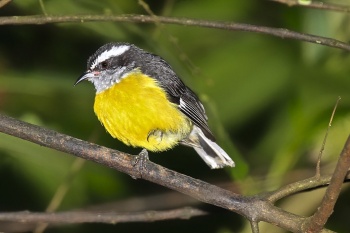- Coereba flaveola
Identification
11cm
Dark grey upperparts, black crown, yellow underparts and rump, prominent white eyestripe, slender, curved bill.
The subspecies differ in coloration, especially the throat, but also presence/absence of a white spot on the wing, and the amount of contrast on the rump (most are yellow). Population in St. Vincent and Grenada have an all-black color phase. Several subspecies on islands off Venezuela are sooty (some even blackish) all over.
The sexes are alike, except that the adult male develops red gape edges.
Distribution
Mexico throughout the Caribbean, Central America, and South America to Bolivia and Argentina.
Taxonomy
The Bananaquit is the only member of its genus and the only member of its family.
Subspecies
Forty-one subspecies are included in the Clements checklist[1]
- C. f. bahamensis: Bahamas (Great Bahama and Little Abaco to Grand Turk)
Caribbean Group
- C. f. tricolor: Isla Providéncia (western Caribbean Sea)
- C. f. oblita: Isla San Andrés (western Caribbean Sea)
- C. f. sharpei: Grand Cayman, Little Cayman and Cayman Brac
- C. f. flaveola: Jamaica
- C. f.a bananivora: Hispaniola, Gonâve, Petite Cayemite and Île-à-Vache
- C. f. nectarea: Tortue Island (off northern Haiti)
- C. f. portoricensis: Puerto Rico
- C. f. sanctithomae: Virgin Islands (including Vieques and Culebra)
- C. f. newtoni: St. Croix (Virgin Islands)
- C. f. bartholemica: Northern Lesser Antilles
- C. f. martinicana: Martinique and St. Lucia (Lesser Antilles)
- C. f. barbadensis: Barbados (Lesser Antilles)
- C. f. atrata: St. Vincent (Lesser Antilles)
- C. f. aterrima: Grenada and the Grenadines (Lesser Antilles)
- C. f. uropygialis: Netherlands Antilles (Aruba and Curaçao)
- C. f. caboti: Eastern Mexico (Cozumel Island, Holbox Island, Cancún and Cayo Culebra)

Photo by Stanley Jones
Umbrellabird Lodge, Buenaventura Reserve, Piñas, El Oro Province, Ecuador, November 2014
Mainland Group
- C. f. mexicana: South-eastern Mexico (Veracruz) to western Panama (Veraguas) and Coiba Island
- C. f. cerinoclunis: Pearl Islands (Bay of Panama)
- C. f. columbiana: Tropical eastern Panama to south-western Colombia and southern Venezuela (Amazonas)
- C. f. bonariensis: Bonaire Island (Netherlands Antilles)
- C. f. melanornis: Northern Venezuela (Cayo Sal off Chiririviche)
- C. f. lowii: Islas Los Roques (off northern Venezuela)
- C. f. ferryi: Isla La Tortuga (off northern Venezuela)
- C. f. frailensis: Isla de Puerto Real and Morro El Fondeadero (off Venezuela)
- C. f. laurae: Isla Testigo Grande and Isla Conejo (off northern Venezuela)
- C. f. luteola: Tropical northern Colombia to northern Venezuela; Trinidad and Tobago
- C. f. obscura: Tropical north-eastern Colombia and western Venezuela
- C. f. minima: Tropical eastern Colombia to southern Venezuela, the Guianas and northern Brazil
- C. f. montana: Highlands of western Venezuela (Mérida and Táchira)
- C. f. caucae: Western Colombia (upper Cauca Valley)
- C. f. gorgonae: Gorgona Island (off western Colombia)
- C. f. intermedia: South-Western Colombia to northern Peru, south-western Venezuela and western Brazil
- C. f. bolivari: Eastern Venezuela (lower Orinoco River Valley)
- C. f. guianensis: Tropical eastern Venezuela (Bolívar) and adjacent Guyana
- C. f. roraimae: Tepuis of south-eastern Venezuela, north-western Brazil and adjacent south-western Guyana
- C. f. pacifica: Arid north-western Peru (Lambayeque, western La Libertad and Ancash)
- C. f. magnirostris: Northern Peru (upper Marañón Valley)
- C. f. dispar: Central Peru (San Martín) to north-western Bolivia (La Paz)
- C. f. chloropyga: Tropical southern Peru to Bolivia, Paraguay, western Brazil and north-eastern Argentina
- C. f. alleni: Plateau of central Brazil (Mato Grosso) and eastern Bolivia
A recent paper[3] describes that not all subspecies are well differentiated at the DNA level. The paper also proposes that the origin of the Bananaquit was in the Bahamas or in the western Greater Antilles and that the species in several rounds have spread from there through the Lesser Antilles to the mainland where it has then spread to much of South America and Central America.
Habitat
Adaptable from gardens to rainforest. Observed at heights around 800 m.
Behaviour
A very active bird, rarely still. Not afraid of human presence. In some areas known to come to tables on outdoor restaurants and eat sugar out of the jar.
Diet
The diet includes nectar, fruit and insects.
References
- Clements, J. F., T. S. Schulenberg, M. J. Iliff, D. Roberson, T. A. Fredericks, B. L. Sullivan, and C. L. Wood. 2015. The eBird/Clements checklist of birds of the world: v2015, with updates to August 2015. Downloaded from http://www.birds.cornell.edu/clementschecklist/download/
- BF Member observations
- Paper describing a phylogeographic analysis of the Bananaquit
- BF Member observations
Recommended Citation
- BirdForum Opus contributors. (2024) Bananaquit. In: BirdForum, the forum for wild birds and birding. Retrieved 18 April 2024 from https://www.birdforum.net/opus/Bananaquit
External Links






